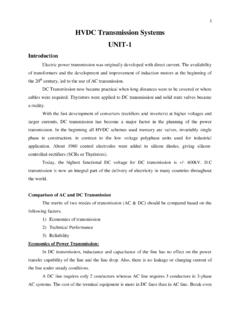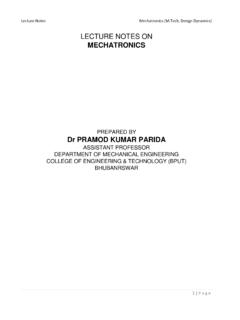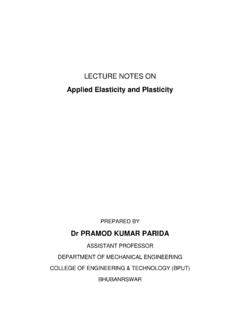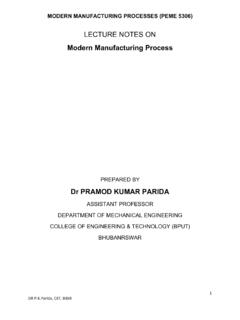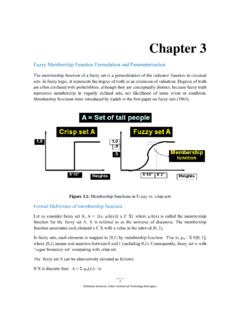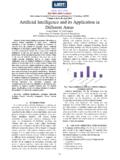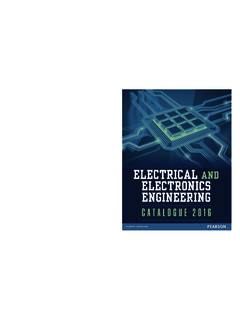Transcription of LECTURE NOTES ON PRINCIPLES OF SOFT COMPUTING
1 1 LECTURE NOTES ON PRINCIPLES OF SOFT COMPUTING PREPARED BY DR. PRASHANTA KUMAR PATRA COLLEGE OF ENGINEERING AND TECHNOLOGY, BHUBANESWAR 2 Introduction Basics of Soft COMPUTING What is Soft COMPUTING ? The idea of soft COMPUTING was initiated in 1981 when Lotfi A. Zadeh published his first paper on soft data analysis What is Soft COMPUTING , Soft COMPUTING . Springer-Verlag Germany/USA 1997.] Zadeh, defined Soft COMPUTING into one multidisciplinary system as the fusion of the fields of fuzzy logic , neuro - COMPUTING , Evolutionary and Genetic COMPUTING , and Probabilistic COMPUTING . Soft COMPUTING is the fusion of methodologies designed to model and enable solutions to real world problems, which are not modeled or too difficult to model mathematically. The aim of Soft COMPUTING is to exploit the tolerance for imprecision, uncertainty, approximate reasoning, and partial truth in order to achieve close resemblance with human like decision making.
2 The Soft COMPUTING development history SC = EC + NN + FL Soft Evolutionary Neural fuzzy COMPUTING COMPUTING Network logic Zadeh Rechenberg McCulloch Zadeh 1981 1960 1943 1965 EC = GP + ES + EP + GA Evolutionary Genetic Evolution Evolutionary Genetic COMPUTING Programming Strategies Programming Algorithms Rechenberg Koza Rechenberg Fogel Holland 1960 1992 1965 1962 1970 3 Definitions of Soft COMPUTING (SC) Lotfi A. Zadeh, 1992 : Soft COMPUTING is an emerging approach to COMPUTING which parallel the remarkable ability of the human mind to reason and learn in a environment of uncertainty and imprecision . The Soft COMPUTING consists of several COMPUTING paradigms mainly : fuzzy Systems, Neural Networks, and Genetic Algorithms. fuzzy set : for knowledge representation via fuzzy If Then rules.
3 Neural Networks : for learning and adaptation Genetic Algorithms : for evolutionary computation These methodologies form the core of SC. Hybridization of these three creates a successful synergic effect; that is, hybridization creates a situation where different entities cooperate advantageously for a final outcome. Soft COMPUTING is still growing and developing. Hence, a clear definite agreement on what comprises Soft COMPUTING has not yet been reached. More new sciences are still merging into Soft COMPUTING . Goals of Soft COMPUTING Soft COMPUTING is a new multidisciplinary field, to construct new generation of Artificial Intelligence, known as Computational Intelligence. The main goal of Soft COMPUTING is to develop intelligent machines to provide solutions to real world problems, which are not modeled, or too difficult to model mathematically.
4 Its aim is to exploit the tolerance for Approximation, Uncertainty, Imprecision, and Partial Truth in order to achieve close resemblance with human like decision making. Approximation : here the model features are similar to the real ones, but not the same. 4 Uncertainty : here we are not sure that the features of the model are the same as that of the entity (belief). Imprecision : here the model features (quantities) are not the same as that of the real ones, but close to them. Importance of Soft COMPUTING Soft COMPUTING differs from hard (conventional) COMPUTING . Unlike hard COMPUTING , the soft COMPUTING is tolerant of imprecision, uncertainty, partial truth, and approximation. The guiding principle of soft COMPUTING is to exploit these tolerance to achieve tractability, robustness and low solution cost. In effect, the role model for soft COMPUTING is the human mind.
5 The four fields that constitute Soft COMPUTING (SC) are : fuzzy COMPUTING (FC), Evolutionary COMPUTING (EC), Neural COMPUTING (NC), and Probabilistic COMPUTING (PC), with the latter subsuming belief networks, chaos theory and parts of learning theory. Soft COMPUTING is not a concoction, mixture, or combination, rather, Soft COMPUTING is a partnership in which each of the partners contributes a distinct methodology for addressing problems in its domain. In principal the constituent methodologies in Soft COMPUTING are complementary rather than competitive. Soft COMPUTING may be viewed as a foundation component for the emerging field of Conceptual Intelligence. 5 fuzzy COMPUTING In the real world there exists much fuzzy knowledge, that is, knowledge which is vague, imprecise, uncertain, ambiguous, inexact, or probabilistic in nature.
6 Human can use such information because the human thinking and reasoning frequently involve fuzzy information, possibly originating from inherently inexact human concepts and matching of similar rather then identical experiences. The COMPUTING systems, based upon classical set theory and two-valued logic , can not answer to some questions, as human does, because they do not have completely true answers. We want, the COMPUTING systems should not only give human like answers but also describe their reality levels. These levels need to be calculated using imprecision and the uncertainty of facts and rules that were applied. fuzzy Sets Introduced by Lotfi Zadeh in 1965, the fuzzy set theory is an extension of classical set theory where elements have degrees of membership. Classical Set Theory Sets are defined by a simple statement describing whether an element having a certain property belongs to a particular set.
7 When set A is contained in an universal space X, 6 then we can state explicitly whether each element x of space X "is or is not" an element of A. Set A is well described by a function called characteristic function A. This function, defined on the universal space X, assumes : value 1 for those elements x that belong to set A, and value 0 for those elements x that do not belong to set A. The notations used to express these mathematically are : [0, 1] A(x) = 1 , x is a member of A Eq.(1) A(x) = 0 , x is not a member of A Alternatively, the set A can be represented for all elements x X by its characteristic function A (x) defined as 1 if x X A (x) = Eq.(2) 0 otherwise Thus, in classical set theory A (x) has only the values 0 ('false') and 1 ('true''). Such sets are called crisp sets. 7 Crisp and Non-crisp Set As said before, in classical set theory, the characteristic function A(x) of Eq.
8 (2) has only values 0 ('false') and 1 ('true''). Such sets are crisp sets. For Non-crisp sets the characteristic function A(x) can be defined. The characteristic function A(x) of Eq. (2) for the crisp set is generalized for the Non-crisp sets. This generalized characteristic function A(x) of Eq.(2) is called membership function. Such Non-crisp sets are called fuzzy Sets. Crisp set theory is not capable of representing descriptions and classifications in many cases; In fact, Crisp set does not provide adequate representation for most cases. The proposition of fuzzy Sets are motivated by the need to capture and represent real world data with uncertainty due to imprecise measurement. The uncertainties are also caused by vagueness in the language. 8 Example 1 : Heap Paradox This example represents a situation where vagueness and uncertainty are inevitable.
9 - If we remove one grain from a heap of grains, we will still have a heap. - However, if we keep removing one-by-one grain from a heap of grains, there will be a time when we do not have a heap anymore. - The question is, at what time does the heap turn into a countable collection of grains that do not form a heap? There is no one correct answer to this question. Example 2 : Classify Students for a basketball team This example explains the grade of truth value. - tall students qualify and not tall students do not qualify - if students m tall are to be qualified, then should we exclude a student who is 1/10" less? or should we exclude a student who is 1" shorter? Non-Crisp Representation to represent the notion of a tall person. A student of height would belong to both tall and not tall sets with a particular degree of the height increases the membership grade within the tall set would increase whilst the membership grade within the not-tall set would decrease.
10 9 Capturing Uncertainty Instead of avoiding or ignoring uncertainty, Lotfi Zadeh introduced fuzzy Set theory that captures uncertainty. In the case of Crisp Sets the members of a set are : either out of the set, with membership of degree " 0 ", or in the set, with membership of degree " 1 ", Therefore, Crisp Sets fuzzy Sets In other words, Crisp Sets are Special cases of fuzzy Sets. 10 Example 2: Set of SMALL ( as non-crisp set) Example 1: Set of prime numbers ( a crisp set) If we consider space X consisting of natural numbers 12 ie X = {1, 2, 3, 4, 5, 6, 7, 8, 9, 10, 11, 12} Then, the set of prime numbers could be described as follows. PRIME = {x contained in X | x is a prime number} = {2, 3, 5, 6, 7, 11} A Set X that consists of SMALL cannot be described; for example 1 is a member of SMALL and 12 is not a member of SMALL. Set A, as SMALL, has un-sharp boundaries, can be characterized by a function that assigns a real number from the closed interval from 0 to 1 to each element x in the set X.
